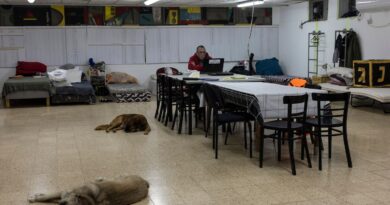Russia destroyed Ukraine’s energy sector, so it’s being rebuilt green
“The war, of course, is a tragedy, but it depends on you, how you react to it,” said Volodymyr Kudrytskyi, CEO of Ukraine’s state electricity distributor, Ukrenergo. “You can say ‘Okay, it’s a horrible situation, and we are just victims’ — or we can try to build back better, to come back in better shape.”
The plan is to switch from large smoke-belching thermal power facilities — Ukraine has nine of those, which provide electricity to much of the country — to a mix of renewable energy like wind and solar, battery storage and biofuel installations.
At the same time, officials say, there will be a vast network of smaller gas-fired turbines spread around the country, producing just enough electricity to power a small town or city district, that are also less vulnerable to attack.
“We cannot say that it’s a good thing that the war led to this. But we can say … it’s our strategic task to use the situation,” Kudrytskyi said. He added that, because of Russia’s invasion, Ukraine will introduce a low-carbon energy system before many European countries.
Energy sector crippled ahead of winter
The task is daunting, however. Ukraine is undertaking an overhaul of its energy sector as it remains locked in battle with Russia. What’s more, authorities must attract outside investors and financing, arrange some form of wartime insurance and create a regulatory framework for a new, decentralized energy system.
Ukraine is already partially a clean-energy country. Around half of its electricity comes from its nuclear power plants, which produce no emissions. Hydroelectric plants provide some electrical capacity, but the Russians have targeted them extensively. Green energy like solar and wind has dropped sharply since the start of the war but made up around 10 percent of production as of last year, the country’s Energy Ministry said.
GET CAUGHT UP
Stories to keep you informed
However, thermal plants are crucial and necessary to cover short-term increases in consumption.
Because of Russian airstrikes, Ukraine has lost around nine gigawatts of the 18 gigawatts needed for peak consumption this winter — far too much to recover in a short period of time. Officials say electricity could be limited to five to seven hours a day — or less — during the frigid winter months.
Ukrainian officials are trying to cobble together enough equipment from outside the country to keep the blackouts at a manageable level. Some of that equipment will go to repair the thermal power plants that are salvageable, officials said.
But the Ukrainian government has also begun to purchase the small gas turbines, which officials hope will generate somewhere between a half gigawatt and one gigawatt this winter and help cities provide basic services in the case of sudden blackouts.
As more sources of renewable energy come online in the ensuing years, officials say, the dependence on the turbines will lessen, and they will be used primarily to balance the energy load in the electrical grid.
Ultimately, there could be thousands of these units around the country. Together with the wind and solar farms, they would make it much harder for Russian missiles to target the energy system.
“Just imagine a situation two, three years from now where we have these hundreds of new gas-generation installations and we have wind farms, some more solar farms, biomass where it’s possible — it will be really a quite robust system against missile attacks,” said Yuri Kubrushko, founder of Imepower, a Ukrainian energy consultancy.
“Because it’s quite easy for Russians to target 10 large power plants, it’s really a no-brainer,” he said. But when there is a system of smaller units, “it’s really not worth shooting an Iskander [ballistic missile] at every two- or three-megawatt gas engine in every small town.”
There are a host of obstacles, however — not least the challenge of attracting investors to a country engaged in the largest European conflict since World War II.
Since March, Russian forces have regularly pummeled Ukraine with missiles and drones, often damaging energy facilities that had only recently been repaired after previous attacks. DTEK power plants, for instance, have been attacked more than 180 times, according to the company.
Rolling power outages have been introduced to deal with the energy shortfall this summer.
Major international players “would be rather reluctant to commit to investments in Ukraine during times of war,” said Grzegorz Zielinski, head of the European Bank of Reconstruction and Development’s Energy Europe team.
“So the approach is different, is very sort of bottom up, identifying those few investors who are willing to commit equity,” he said. “That predominantly means the Ukrainian investors because, for them, the perception of risk is very different.”
Some outside firms are interested nonetheless. The EBRD signed a joint-venture agreement with Germany’s Goldbeck Solar Investment at the Ukraine Recovery Conference last month in Berlin to develop some 500 megawatts of solar energy over the next three to five years.
Securing international financing is also a problem — along with convincing insurance companies to provide risk coverage. “We don’t have access to commercial funding,” said Maxim Timchenko, CEO of DTEK, Ukraine’s largest private energy company.
DTEK provides the bulk of thermal-generated electricity in Ukraine — the company has lost close to 90 percent of its generating capacity, Timchenko said — but it is also a major player in renewable energy. A Russian missile attack recently targeted one of the company’s solar farms, but the damage was quickly repaired, as solar panels are much easier to fix and replace than power plants.
Timchenko said he fully supports turning Ukraine into clean-energy paradise, and experts say DTEK will more than likely play a role in the project. However, international institutions are hesitant to provide financing to the company because it is owned by Rinat Akhmetov, Ukraine’s richest oligarch, which Western diplomats say raises corporate governance issues.
Long-term projects, slow return
It will also be difficult to come up with an efficient system to regulate a decentralized grid for the whole of Ukraine — a country roughly the size of Texas — while assuring investors that they will see a steady revenue stream.
“If someone wants to invest in renewables — where the useful life of the asset is 20, 25, 30 years — they want to have a decent degree of comfort that the regulatory framework is going to stay there for a long time,” said the EBRD’s Zielinski.
Ukraine’s previous forays to support renewable energy have been mixed, and reform of the energy industry — a traditionally opaque and highly lucrative area for the country’s oligarchs — has long been blocked, observers say. Last year, the Ukrainian government was reported to owe renewable-energy producers some $500 million.
If the clean-energy plan is carried out, it will cost billions of dollars and ultimately take years to implement. But Ukrenergo’s Kudrytskyi said Ukraine must start immediately to be prepared “for the winters to come.”
“Because if we do not start this now, the winter of 2025-2026 will be much more challenging that the winter of 2024-2025.”
Kostiantyn Khudov contributed to this report.



